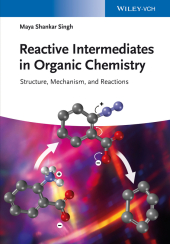 Neuerscheinungen 2014Stand: 2020-02-01 |
Schnellsuche
ISBN/Stichwort/Autor
|
Herderstraße 10
10625 Berlin
Tel.: 030 315 714 16
Fax 030 315 714 14
info@buchspektrum.de |

Maya Shankar Singh
Reactive Intermediates in Organic Chemistry
Structure, Mechanism, and Reactions
1. Aufl. 2014. 296 S. 150 SW-Abb., 10 Farbabb. 244 mm
Verlag/Jahr: WILEY-VCH 2014
ISBN: 3-527-33594-3 (3527335943)
Neue ISBN: 978-3-527-33594-7 (9783527335947)
Preis und Lieferzeit: Bitte klicken
Diese aktuelle und detaillierte Einführung in die wichtigsten Typen reaktiver Zwischenprodukte der modernen organischen Chemie spiegelt die langjährige Lehrerfahrung des Autors wider und bietet unzählige Übungen zur eigenständigen Kontrolle des Lernfortschritts.
Most reactions in organic chemistry do not proceed in a single step but rather take several steps to yield the desired product. In the course of these multi-step reaction sequences, short-lived intermediates can be generated that quickly convert into other intermediates, reactants, products or side products. As these intermediates are highly reactive, they cannot usually be isolated, but their existence and structure can be proved by theoretical and experimental methods. Using the information obtained, researchers can better understand the underlying reaction mechanism of a certain organic transformation and thus develop novel strategies for efficient organic synthesis.
The chapters are clearly structured and are arranged according to the type of intermediate, providing information on the formation, characterization, stereochemistry, stability, and reactivity of the intermediates. Additionally, representative examples and a problem section with different levels of difficulty are included for self-testing the newly acquired knowledge.
By providing a deeper understanding of the underlying concepts, this is a musthave reference for PhD and Master Students in organic chemistry, as well as a valuable source of information for chemists in academia and industry working in the field. It is also ideal as primary or supplementary reading for courses on organic chemistry, physical organic chemistry or analytical chemistry.
Preface
INTRODUCTION
Reaction Mechanism and Reaction Arrows
Properties and Characteristics of a Reaction
Summary
CARBOCATIONS
Introduction
History
Sturctures and Geometry of Carbocations
Generation of Carbocation
Carbocation Stability
Detection of Carbocations
Fate of Carbocations
Nonclassical Carbocations
Radical Cations
Summary
CARBANIONS
Structure and Geometry of Carbanions
Generation of Carbanions
Stability of Carbanions
Reactions of Carbanions
Enolate Reactions with Carbonyl Groups
Rearrangements of Carbanions
Chiral Carbanions
Carbanions and Tautomerism
Summary
RADICALS
Introduction
Detection and Characterization of Radicals
Structure and Bonding of Radicals
Generation of Free Radicals
Stability of Radicals
Reactions of Free Radicals
Stereochemistry of Radical Reactions
Biradicals
Summary
CARBENES
Structure and Geometry of Carbenes
Generation of Carbenes
Reactions of Carbenes
Carbenes and Carbene Ligands in Organometallic Chemistry
Summary
NITRENES
Introduction
Structure and Reactivity
Generation of Nitrenes
Reactions of Nitrenes
Summary
MISCELLANEOUS INTERMEDIATES
Arynes
Ketenes and Cumulenes
ortho-Quinone Methides
Zwitterions and Dipoles
Antiaromatic Systems
Tetrahedral Intermediates
Summary
Index


